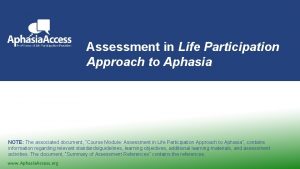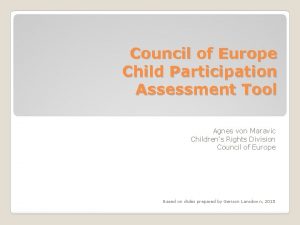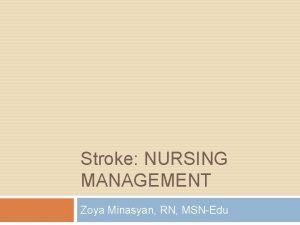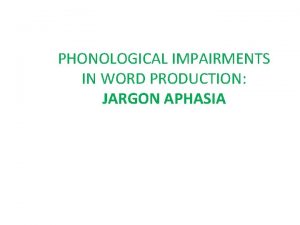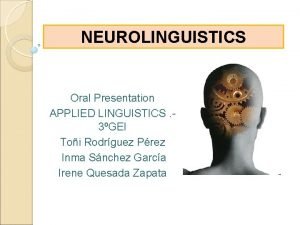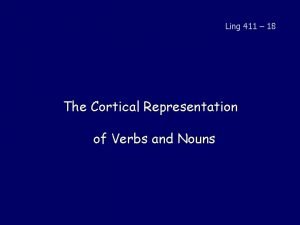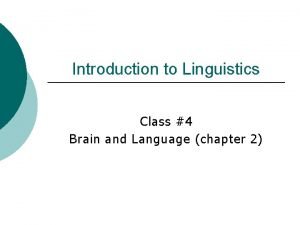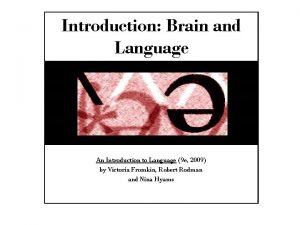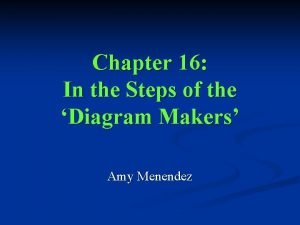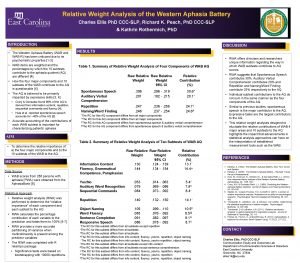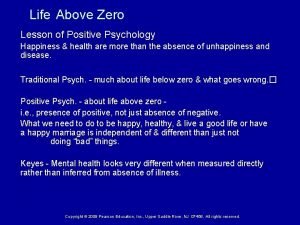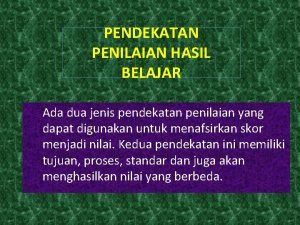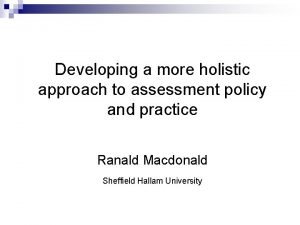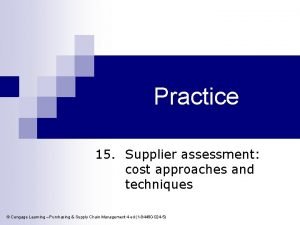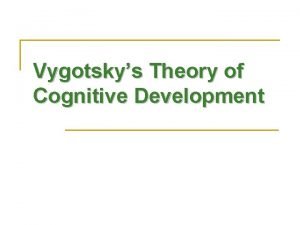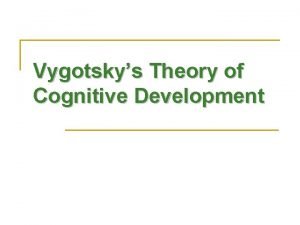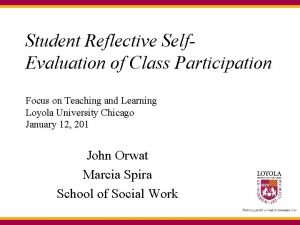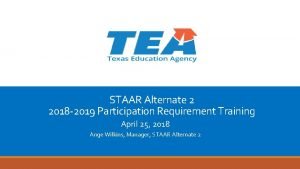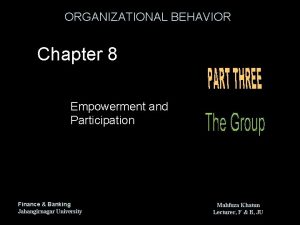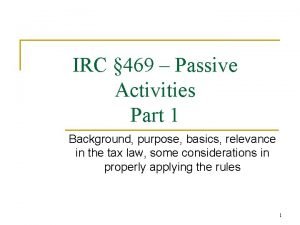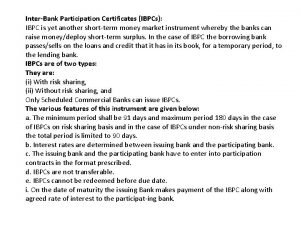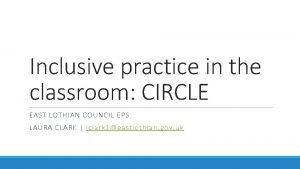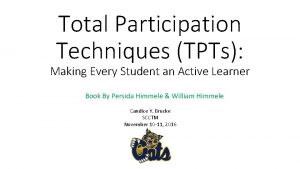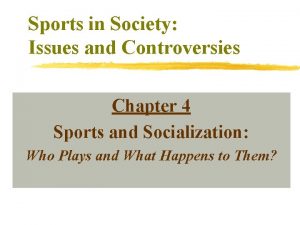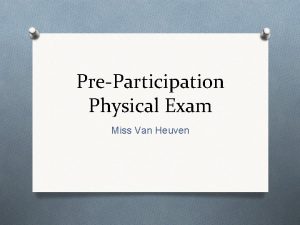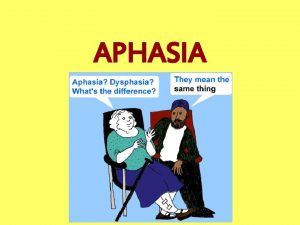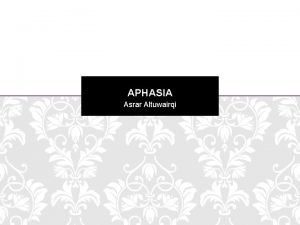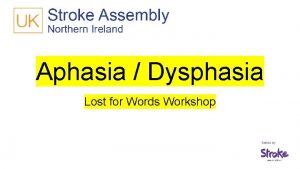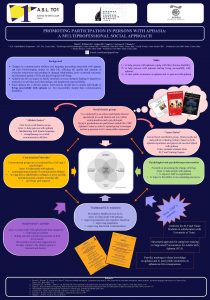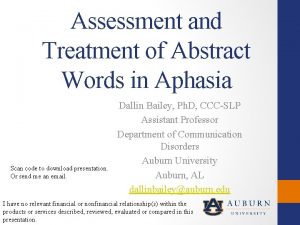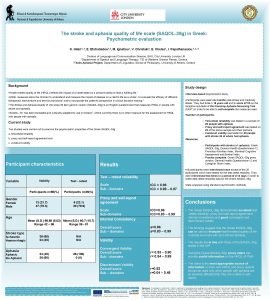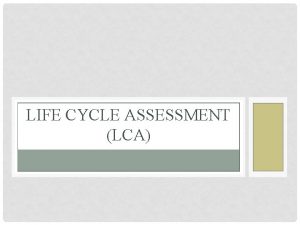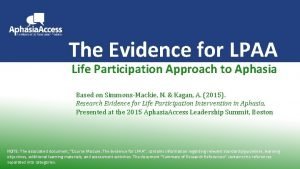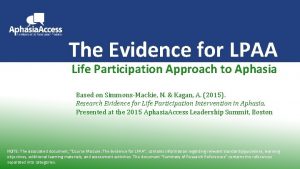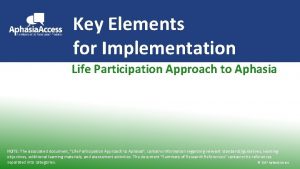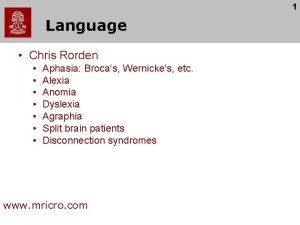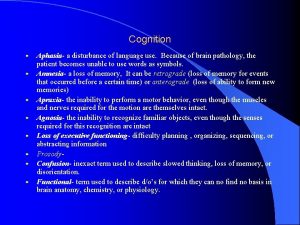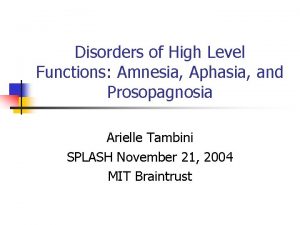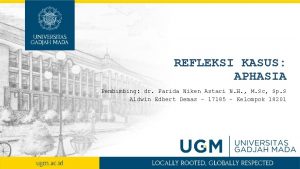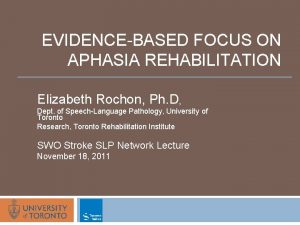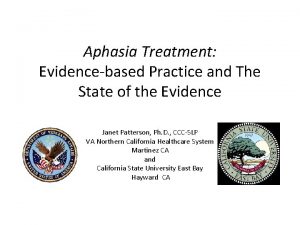Assessment in Life Participation Approach to Aphasia NOTE
































































- Slides: 64

Assessment in Life Participation Approach to Aphasia NOTE: The associated document, “Course Module: Assessment in Life Participation Approach to Aphasia”, contains information regarding relevant standards/guidelines, learning objectives, additional learning materials, and assessment activities. The document, “Summary of Assessment References” contains the references. www. Aphasia. Access. org

Academic Module Sponsors: www. Aphasia. Access. org

Academic Module Committee www. Aphasia. Access. org

About Aphasia Access • Received its 501 c(3) designation in May 2014 • Membership includes representation from 33 states and 5 Canadian Provinces. The Life Participation Approach to Aphasia (LPAA) is the core philosophy. • Produces videos, webinars and podcasts that are used internationally to educate speech-language pathologists, healthcare professionals, students, nonprofit board members and community leaders. • Advocates for aphasia care and communication access throughout health care.

Assessment in Life Participation Approach to Aphasia How can SLPs assess people with aphasia using the LPAA? www. Aphasia. Access. org

Target Audience This presentation has been developed for speechlanguage pathology (SLP) students and current practitioners and is one portion of a series of LPAA academic modules for adoption in pre-professional and continuing education. www. Aphasia. Access. org

LPAA Curriculum Modules The Working Group on Academic Curriculum of the Education and Research Committee of Aphasia. Access has developed this module to • Describe principles and processes for assessment when adopting the Life Participation Approach to Aphasia www. Aphasia. Access. org

Learning Objectives Upon successful completion of this learning module, participants will be able to: • Differentiate between using the LPAA model from impairment -based models of assessment • Apply the LPAA model to assessment processes and procedures for people with aphasia www. Aphasia. Access. org

This module will cover… 1) What is the Life Participation Approach to Aphasia (LPAA)? 2) Why use the LPAA in assessment of people with aphasia? 3) When? Where? and How can SLPs use the LPAA in assessment of people with aphasia? www. Aphasia. Access. org

1. What is the Life Participation Approach to Aphasia (LPAA)? A brief summary www. Aphasia. Access. org

Life Participation Approach to Aphasia (LPAA) LPAA is an underlying philosophy which supports treatment for individuals with aphasia (LPAA project group, 2000). LPAA Core Values • Goal is enhancement of life participation • Services are available to all affected by aphasia • Changes in the environment are essential to participation • Success is measured by documented life changes • Services are available as needed at all stages www. Aphasia. Access. org

LPAA places life concerns of people with aphasia at the center of all decisions. Clinicians strengthen daily participation in activities of their client’s choice. The clinician works not only on communication but also on establishing and maintaining social links…for it is within this environment that one communicates. www. Aphasia. Access. org

LPAA expands the role of the SLP • Coach • Problem Solver • Support Person PWA Communication Partner Goal: To overcome challenges with participating in activities www. Aphasia. Access. org

2. Why use LPAA in assessment of people with aphasia? A foundation in best practices www. Aphasia. Access. org

LPAA Assessment is best practice • Aligns with practice guidelines ASHA Scope of practice, Aphasia United, Australian Aphasia Pathway • Complements impairment level assessment of language (Hinckley, 2015) • Incorporates activity, participation, environmental and personal factors http: //www. asha. org/uploaded. Files/ICF-Aphasia. pdf • Recognizes critical role of patient-reported outcomes (Boothe & Richardson, , 2011) www. Aphasia. Access. org

LPAA assessment is purposeful • Determines current activity and participation levels • Identifies future activity and participation goals • Evaluates factors that impact participation: communication, physical, personal and environmental factors • Reveals immediate and future needs for communication • Assesses social connectedness and social support • Considers emotional well-being and quality of life • Guides further assessment and treatment www. Aphasia. Access. org

LPAA assessment is personally meaningful “What do people with aphasia want ? ” People with aphasia and their families want Activity and participation goals (Worrall et al. , 2011) People with aphasia want to improve communication. . and… return to valued activities (hobbies, returning to work, to travel) (Rohde, Townley-O'Neill et al. , 2012) www. Aphasia. Access. org

LPAA assessment is relationship centered A change in perspective from impairment-based to LPAA assessment is based upon relationship centered care. • • Relationships in health care include the personhood of the participants Affect and emotion are important components of these relationships All health care relationships occur with reciprocal influence Genuine relationships in health care morally valuable (Beach, Inui & Relationship-Centered Care Research Network, 2006) www. Aphasia. Access. org

LPAA Assessment is consistent with the WHO-ICF Impairments: problems in body function or structure Activity: doing a task or action. Participation: involvement in a life situation. Environmental Factors: physical, social and attitudinal Personal Factors: age, coping styles, education http: //www. who. int/classifications/icf/icfbeginnersguide. pdf? ua=1 http: //www. who. int/classifications/icfchecklist. pdf? ua=1 www. Aphasia. Access. org

LPAA Assessment is informed by A-FROM Aphasia Framework for Outcome Measurement (Kagan et al. , 2007) A-FROM is conceptualized around four domains Impairment Participation Environment Personal factors Premise focuses on increasing access while reducing barriers in healthcare facilitating participation in personally relevant activities www. Aphasia. Access. org

Considers: • Conversations • Relationships • Leisure activities • Volunteer opportunities • Community activities Considers: • Family’s skills • Communication support • Friends’ attitudes and knowledge • Adaptation to activities Image retrieved 4/24/17 from: https: //s-media-cacheak 0. pinimg. com/originals/5 a/7 a/8 b/5 a 7 a 8 bfda 03065 cc 0214711 a 4132 b 1 f 7. png A-FROM (Kagan www. Aphasia. Access. org et al. , 2008) Considers: • Confidence • Self-esteem • Identity and autonomy Considers: • Language activities to support specific roles • Vocabulary for KEY interests • Scripts for specific activities

Comparison of impairment-oriented and LPAA Click to edit Master assessment (Whiteside, 2017, LPAA title Academicstyle Module) Impairment-oriented Assessment LPAA Assessment Language functions intrinsic to the individual All domains of living with aphasia • • • Spoken language production Understanding spoken language Written language production Understanding written language Modalities www. Aphasia. Access. org • • • Language & communication strengths Participation goals Environment and context Personal factors Emotional well-being

3. When, where, and how do SLPs apply LPAA assessment? A primer in LPAA assessment www. Aphasia. Access. org

Times foredit LPAA assessment Click to Master title style Assessment using the LPAA takes place across the lifespan of a person living with aphasia (Simmons-Mackie, King, & Beukelman, 2013). • Soon after onset in acute care • During active rehabilitation • Any time new needs arise www. Aphasia. Access. org

Example: After onset in Acute Click to edit Master title style. Care When the SLP arrived to assess Mr. A’s communication, his wife was sitting tearfully next to him. Mr. A had been unable to read his menu and did not like anything on his food tray. Using the process of Contextual Analysis, the SLP observed: ENVIRONMENTAL factors (text-based menu) PERSONAL factors (food preferences and caring spouse) and LANGUAGE factors (reduced reading comprehension). Using a process of Dynamic Assessment, a 6 -square picture menu of breakfast items was used. Mr. A selected preferred foods. His wife observed this supported conversation approach. Identified LPAA Goal: Mr. A will select his preferred food items using a pictographic menu www. Aphasia. Access. org

Places LPAA assessment Click toforedit Master title style Assessing using the LPAA takes place within all settings where the SLP meets people with aphasia. Hospital (Mc. Cooey - O’Halloran et al. , 2004) Skilled nursing facility Home (Haley et al. , 2010) Outpatient clinic Aphasia Center (Kagan et al. , 2008) Community (Dalemans et al. , 2010) www. Aphasia. Access. org

Example: Home Care title style Click to edit Master Mr. and Mrs. B. talked with the home care SLP about how life had changed since coming home from the hospital. Using a patient report tool, the Communication Activities Checklist (COMACT) (Cruice, 2001, Cruice et al. , 2010), the client’s communication interests were assessed. The SLP determined that Mr. B. wanted to read more. Using the A-FROM framework, the SLP considered: ENVIRONMENTAL factors (He and his wife read in the living room every evening) PERSONAL factors (They missed the social closeness of reading together) and LANGUAGE factors (Significantly reduced reading comprehension). Identified LPAA Goal: To enjoy reading together with wife using audio books from public library www. Aphasia. Access. org

Assessment can. Master be ongoing, as style new needs arise Click to edit title What new participation need or interest has the person identified? What are possible communication participation barriers? Needs access to public transportation system Able to use phone to reserve the metro van? Wants to volunteer on a community board Able to listen to a group discussion and take notes? Needs a new apartment Able to read an apartment search phone app? www. Aphasia. Access. org

Methods for assessment in LPAA 1. Standardized Assessments empirically developed with statistical reliability and validity 2. Self-Report/Family/ or SLP Report Measures rating scales, inventories or questionnaires 3. . Ethnographic Interviewing / Biographic Narrative open-ended questions, restatement, and clarification 4. Observation and Contextual Analysis variables affecting and interacting with communication participation 5. Dynamic Assessment real-life situation task assessment; treatment applied and changes noted http: //www. asha. org/Practice-Portal/Clinical-Topics/Late-Language-Emergence/Assessment-Tools-Techniques-and. Data-Sources/ www. Aphasia. Access. org

Examples of assessment The following 5 slides will highlight brief clinical examples of LPAA assessment using: 1) 2) 3) 4) 5) Standardized Assessment Tool An Interviewing Process Self-Report Tools Contextual Analysis Dynamic Assessment www. Aphasia. Access. org

LPAA Assessment: 1) Standardized Tool Purpose Tool Outcome www. Aphasia. Access. org To reveal immediate needs for communication participation Mr. A, 78, living alone after recent CVA Communication Activities of Daily Living - 3 (Holland, Fromm, & Wozniak, 2018) Identified impairment in reading prescription instructions; Mr. A needs to manage his medications at home independently.

LPAA Assessment : 2) Interviewing Purpose To identify the individual’s life participation goals Mrs. B, age 63, 3 years post CVA Process: Ethnographic Interviewing (Simmons-Mackie & Damico, 2001) Counseling/coaching (Holland & Nelson, 2013) Outcome: Identified Mrs. B’s participation goal: To present testimony about her recovery in her church WHO-ICF participation domain: d 930 Religion and spirituality (WHO -ICF, 2003; Pollens & Glista, 2016) www. Aphasia. Access. org

LPAA Assessment: 3) Self report Tools Purpose To evaluate current impact of aphasia on participation and emotional well-being Mr. C, 42 year old teacher, anomic aphasia, 2 years post CVA, unable to return to work. Tools Outcome www. Aphasia. Access. org Assessment for Living with Aphasia (ALA) Depression screening (Visual Analog Mood Scale) ALA identified lowest scores in the domain of personal/psychosocial factors; positive screen for depression

LPAA Assessment: 4) Contextual Assessment Purpose To identify impact of environmental factors Pollens & Glista, 2016) Mr. D, age 27, 1 year post CVA, wants to schedule rides from local paratransit system Process Outcome www. Aphasia. Access. org Real-life situation task assessment in natural context When Mr. D attempted to use the telephone system, the ride dispatcher was unable to understand Mr. D’s ride requests. Dispatcher did not demonstrate supportive communication approaches.

LPAA Assessment: 5) Dynamic Assessment (Hersh et al. , 2013; Hersh, 2012) To evaluate current impact of aphasia on participation and to Purpose& Glista, Pollens 2016) guide treatment Mrs. E, 58 with nonfluent aphasia, 3 months post onset Process Outcome www. Aphasia. Access. org At the skilled nursing facility, the Interprofessional Team meeting noted that Mrs. E was not following safety instructions for use of her new walker. This was a barrier to her goal to reside in her own home. The SLP observed PT working with Mrs. E and assessed her ability to follow the spoken instructions. SLP then provided key word visual support to determine impact on following safety instructions. Mrs. E’s personal goal of discharge to her home will require treatment of communication strategies for increasing comprehension of safety instructions.

Program-specific “choice” can be another assessment tool Many Aphasia Centers and Aphasia Groups offer people with aphasia choices from menus of participation activities. Many people with aphasia and their care partners state what they want to do in their lives (Worrall et al. , 2011). The client’s choices can reveal participation needs, interests, and hopes (Glista & Pollens, 2007). www. Aphasia. Access. org

Client Choice Click to edit Master title style Please rate these Do you want to teach other people about Not at all aphasia? Maybe Very much Not at all Maybe Very much Do you want to use the internet and discuss current events? Do you want to improve your spelling and writing? Do you want to visit an Art Museum and discuss the paintings? www. Aphasia. Access. org (Glista & Pollens, 2007)

Additional variables may influence SLP decisions in methods of assessment (Coppens & Simmons-Mackie, 2018) • • Preferences of the person with aphasia Age and life situation/role of the person with aphasia Level of communication ability Cognitive abilities Sensory functioning Availability of time or resources SLP knowledge, experience, and expertise www. Aphasia. Access. org

4. What are some tools used in LPAA assessment? A selection of assessments and interviews www. Aphasia. Access. org

Interviewing…Educating…Counseling How do we listen to truly hear what clients and families want? What’s one thing that will truly make a difference? What is happening in your life - now? What are your hopes for the future? • • Biographic narrative (Corsten et al. , 2013) Coaching/Active listening (Holland & Nelson, 2014) Ethnographic interviewing (Simmons-Mackie & Damico, 2001) Life story narratives (Shadden, 2007; Hinckley, 2015) www. Aphasia. Access. org

Assessments A variety of assessments tools and processes can be used within the LPAA. A selection of assessment descriptions follows in alphabetical order. For a comprehensive list see… Brandenburg, C. , Worrall, L. , Rodriguez, A. , & Bagraith, K. (2015). Crosswalk of participation self-report measures for aphasia to the ICF: What content is being measured? Disability and Rehabilitation, 37(13), 1113 -24. For a comprehensive discussion of assessment related to Quality of Life… See Hilari & Cruice (2017) www. Aphasia. Access. org

TOOL Assessment for Living with Aphasia (Aphasia Institute, 2010) Description Pictographic self-report measure of aphasia-related quality of life across multiple domains that impact life with aphasia Measurement Overall score of person’s perceptions of life with aphasia. Also domain specific scores (language, participation, personal/psychosocial factors and environmental factors). Example Result Person with aphasia expresses high need to resume reading for pleasure in every day activities. www. Aphasia. Access. org

TOOL Aphasia Communication Outcome Measure (ACOM) (Hula et al. , 2015) Description Person with aphasia self reports communicative functioning Measurement Measures perception of how effectively person with aphasia completes communication-related behaviors, tasks, activities, and life situation. Example result Person with aphasia indicates she does not talk very effectively with her best friend and care partner. www. Aphasia. Access. org

TOOL Burden of Stroke Scale – BOSS Description Person with aphasia self reports health status difficulty in functioning across mobility, self-care, swallowing, energy and sleep, communication, cognition, and social relations. Measurement Scores of physical limitations, cognitive limitations, and psychological distress obtained. Example result Person with aphasia indicated difficulty communicating with a familiar person on the phone. www. Aphasia. Access. org (Doyle et al. , 2003)

TOOL Communication Abilities of Daily Living – 3 Description The clinician assesses 1. Reading, writing, and using numbers 2. Social interaction 3. Contextual communication 4. Nonverbal communication 5. Sequential relationships 6. Humor / metaphor /absurdity 7. Internet basics Measurement A raw score is obtained from which percentile rank and stanine score available. Example Result Person with aphasia was successful in using multiple modalities to express ideas. www. Aphasia. Access. org (Holland, Fromm, & Wozniak, 2018)

TOOL Communication Activities Checklist COMACT (Cruice, 2001; Cruice et al. , 2010) Description Person with aphasia self-reports engagement in types of communication activities. Measurement Talking, listening, reading, and writing activities are identified, and frequencies are tallied. Example result Person with aphasia expresses wish to increase talking with her neighbor from once per month to once per week. www. Aphasia. Access. org

TOOL Communication Confidence Rating Scale for Aphasia - CCRSA (Babbit & Cherney, 2010) Description Person with aphasia rates self confidence in 10 examples of social and functional communication. Measurement Determines how self-confident the person with aphasia feels in communication and the change in self confidence over time. Example result Person with aphasia rates self as “moderately” confident in ability to talk with other people. www. Aphasia. Access. org

TOOL Communication Disability Profile - CDP Description Person with aphasia self rates activity, social participation, external influences, and emotional consequences. Pictures facilitate discussion with clinician. Measurement Measures of the impact of aphasia by obtaining scores for individual items. Example result Person with aphasia identified she could not do her own grocery shopping independently. www. Aphasia. Access. org (Swinburn & Byng, 2006)

TOOL Communication Effectiveness Index – CETI Description Communication partner rates functional change in communicating basic needs, life skills, and social needs through questionnaire. Measurement Change in functional communication over time is recorded for 16 items. Example result Spouse reported change in “getting someone’s attention” from not at all able to same as before stroke. www. Aphasia. Access. org (Lomas et al. , 1989)

TOOL Community Integration Questionnaire – CIQ (with or without pictographs) (Dalemans et al. , 2010) Description Person with aphasia selects how often an activity is performed in area of home integration, social integration, and productive activities. Originally developed for TBI survivors; adapted for persons with aphasia Measurement A raw score from 0 - 29 is obtained; the higher the score, the more community integration reported. Example result Person with aphasia reported not grocery shopping for family; she wants to resume responsibility. www. Aphasia. Access. org

TOOL L!V Cards (Life Interests and Values Cards) Description Communicate with person with aphasia or family/friend about valued life activities. Drawings on cards depict life activities in four categories: Home & Community, Creative & Relaxing, Physical, and Social Measurement Determine list of “wants to do more” activities in each area Example result Person with aphasia chose camping and traveling as a family life activity to resume. (Haley et al. , 2010) https: //www. med. unc. edu/ahs/sphs/card/resources/livcards/score-sheets www. Aphasia. Access. org

TOOL Quality of Communication Life Scale - ASHA QCL (Paul et al. , 2004) Description Person with aphasia self rates the impact of aphasia on relationships; communication; interactions; participation in social, leisure, work, and education activities; and overall quality of life. Measurement Vertical analog scale is marked from low to high points using key words and pictures which reflect perceptions of life quality, social roles, and interactions. Example result Person with aphasia chose lowest point of the scale to rate, My role in the family is the same. www. Aphasia. Access. org

TOOL Social Activities Checklist - SOCACT Description Person with aphasia is interviewed to quantify range and frequency of involvement in social activities. Measurement Weekly, biweekly, monthly, rarely, not at all and not applicable used to collect information about social activity and participation. Example result Person with aphasia wants to go to church with his spouse every week. www. Aphasia. Access. org (Cruice et al. , 2010)

TOOL Stroke and Aphasia Quality of Life Scale SAQOL-39 (Hilari et al. , 2003) Description Persons with aphasia evaluate function in physical, psychological, communication, and energy. Measurement Difficulties are reported for 39 items on a 5 -point scale using two formats, e. g. could not do it at all/no trouble at all; definitely yes/definitely no. Example result When asked, During the past week, did you feel withdrawn from other people, person with aphasia chose “definitely yes. ” www. Aphasia. Access. org

TOOL Visual Analog Mood Scale (Stern, 1997) Description Person with aphasia selects from simple schematic faces to report mood states. Measurement Mood states include choices of sad, afraid, angry, tired, energetic, happy, and confused Example result Person with aphasia selects faces depicting sad and afraid during three consecutive sessions. www. Aphasia. Access. org

TOOL WHO-ICF checklist (http: //www. who. int/classifications/icfapptraining/en/) Description This checklist of major categories of the International Classification of Functioning, Disability and Health (ICF) of the World Health Organization can be a practical tool to elicit and record information on the functioning and disability of an individual. Measurement Through an interview, version 2. 1 a, Clinician Form, part 2 collects information about performance and limitations of activities. Example result Person with aphasia has problems with holding conversations with family and friends. www. Aphasia. Access. org

Additional Resources www. Aphasia. Access. org

Additional Resources www. Aphasia. Access. org

5. How do SLPs use LPAA assessment information to design treatment? An Aphasia. Access module on LPAA Treatment www. Aphasia. Access. org

Summary When using the LPAA approach to assessment, the SLP addresses the Language, Participation, Environmental, and Personal Factors domains. The LPAA approach to assessment results in treatment models which can address all of these factors. www. Aphasia. Access. org

Comprehensive LPAA treatment “I want to learn to email with my family” www. Aphasia. Access. org

See Aphasia. Access LPAA Treatment Module

Questions? How will you use the LPAA to assess people with aphasia? www. Aphasia. Access. org

Summary of Assessment References A complete list of references can be found at https: //aphasiaacc. memberclicks. net/assets/Academicmodules/ AA%20 Assessment%20 Course%20 Module%20 Outline%20 Mar ch%2014 -%20 UPDATED 2 AUG 2018. pdf www. Aphasia. Access. org
 Icf checklist
Icf checklist Contoh partial participation
Contoh partial participation Child participation assessment tool
Child participation assessment tool Difference between note making and note taking
Difference between note making and note taking Signal phrases
Signal phrases Difference between note making and note taking
Difference between note making and note taking Financial documents in order
Financial documents in order Debit note example
Debit note example Debit note meaning
Debit note meaning Linear method of note taking
Linear method of note taking Simple discount example
Simple discount example Examples of aphasia
Examples of aphasia Stroke precautions nursing
Stroke precautions nursing Aphasia meaning
Aphasia meaning Jargon aphasia example
Jargon aphasia example Transcortical motor aphasia
Transcortical motor aphasia Anomic aphasia
Anomic aphasia Examples of aphasia
Examples of aphasia Examples of aphasia
Examples of aphasia Examples of aphasia
Examples of aphasia Conduction aphasia
Conduction aphasia Aphasia definition
Aphasia definition Pico question examples aphasia
Pico question examples aphasia Descending inhibition
Descending inhibition Aphasia pathfinder
Aphasia pathfinder Module 36 thinking and language
Module 36 thinking and language Unimodal vs heteromodal association cortex
Unimodal vs heteromodal association cortex Broca's area
Broca's area Expressive aphasia
Expressive aphasia Western aphasia battery
Western aphasia battery Rajeev raizada
Rajeev raizada Happiness definition psychology
Happiness definition psychology Datagram approach and virtual circuit approach
Datagram approach and virtual circuit approach Theoretical models of counseling
Theoretical models of counseling Shower approach marketing
Shower approach marketing Avoidance
Avoidance Cognitive approach vs behavioral approach
Cognitive approach vs behavioral approach Research approaches definition
Research approaches definition Traditional development approach
Traditional development approach Tony wagner's seven survival skills
Tony wagner's seven survival skills Contoh pendekatan hasil
Contoh pendekatan hasil Holistic approach to assessment in education
Holistic approach to assessment in education Cost approaches and techniques in suppler assessment
Cost approaches and techniques in suppler assessment Workers participation in management
Workers participation in management Vygotsky motivation
Vygotsky motivation Guided participation vygotsky
Guided participation vygotsky Class participation self-evaluation essay
Class participation self-evaluation essay Staar alt 2 participation requirements examples
Staar alt 2 participation requirements examples Empowerment and participation in organizational behavior
Empowerment and participation in organizational behavior Section 469 material participation
Section 469 material participation Ibpc in banking
Ibpc in banking Circle participation scale
Circle participation scale Community participation ppt
Community participation ppt Participation constraints in dbms
Participation constraints in dbms Active community participation definition
Active community participation definition Workers participation in management
Workers participation in management Chapter 7 citizen participation in a democracy answers
Chapter 7 citizen participation in a democracy answers Participation level in sport
Participation level in sport Settings
Settings Learner participation in educational settings
Learner participation in educational settings Total participation techniques book
Total participation techniques book Sisters participation in the gathering of israel
Sisters participation in the gathering of israel Pleasure and participation sports
Pleasure and participation sports Office-based pre-participation physical examination
Office-based pre-participation physical examination Lester w. milbrath
Lester w. milbrath
